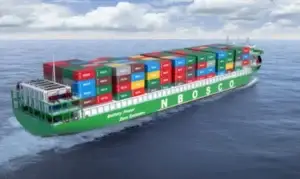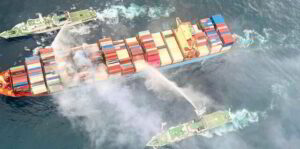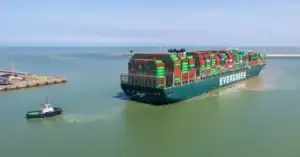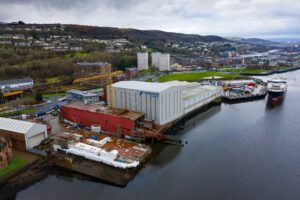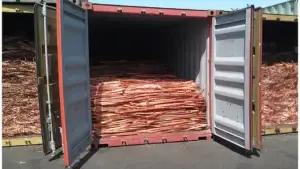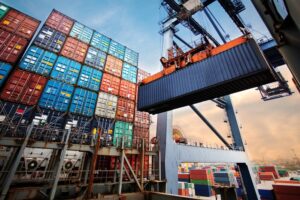Global shortage of shipping containers
Global reliance on shipping containers is key for global trade. AP Photo/Seth Wenig
The global dearth of shipping containers underscores their crucial role in delivering goods to Amazon depots, retail shops, and your doorstep in time for Christmas
You might be currently munching on a banana, savouring your morning coffee, or taking a pause from your work to peruse this piece. Most probably, these products – along with your smartphone, refrigerator and almost every other item in your home – were once loaded onto a large container in a foreign land and travelled thousands of miles on ships across oceans before ultimately landing at your residence.
In the present day, an estimated 90% of the world’s products are shipped via the ocean, with 60% of that – encompassing nearly all your imported fruits, tech gadgets, and appliances – packed into large steel containers. The remainder is primarily commodities such as oil or grains that are directly deposited into the hull. Altogether, about US$14 trillion of the world’s products spend some time inside a hefty metal box.
Simply put, without the standardised container, the global supply chain that society relies on – and that I research – would cease to exist.
A recent scarcity of these containers is causing prices to rise and disrupting supply chains of thousands of products globally. The situation underlines the importance of these simple yet vital freight containers that, from a distance, look like Lego blocks floating on the sea.
Trade prior to the container
Since the inception of commerce, people have used boxes, sacks, barrels and containers of various sizes to transport goods over lengthy distances. Phoenicians in 1600 B.C. Egypt transported wood, textiles and glass to Arabia in sacks via camel-driven caravans. And hundreds of years later, the Greeks utilised ancient storage vessels known as amphorae to transport wine, olive oil, and grain on triremes that sailed the Mediterranean and neighbouring seas to other ports in the region.
Even as trade became more sophisticated, the process of loading and unloading as goods shifted from one mode of transportation to another remained labour-intensive, time-consuming and costly, partly because containers were all shapes and sizes. Containers from a ship being transferred onto a smaller rail car, for example, often had to be opened up and repacked into a boxcar.
Varied-sized packages also meant space on a ship could not be optimised, and they also created weight and balance issues for a vessel. And goods were more likely to suffer damage from handling or theft due to exposure.
A revolution in trade
The U.S. military began to consider the use of standardised small containers for the more efficient transport of weapons, bombs and other materiel to the front lines during World War II.
However, it was not until the 1950s that American businessman Malcolm McLean realised that by standardising the size of the containers used in global trade, loading and unloading of ships and trains could be partially automated, thereby making the shift from one mode of transportation to another seamless. This way, products could stay in their containers from the point of manufacture to delivery, resulting in reduced costs in terms of labour and potential damage.
In 1956 McLean created the standard cargo container, which is essentially the standard today. He initially constructed it with a length of 33 feet – soon increased to 35 – and 8 feet wide and tall.
This system dramatically cut the cost of loading and unloading a ship. In 1956, manually loading a ship cost $5.86 per ton; the standardised container reduced that cost to just 16 cents a ton. Containers also made it much simpler to protect cargo from weather conditions or piracy, since they are made of durable steel and remain locked during transit.
The U.S. extensively used this innovation during the Vietnam War to ship supplies to soldiers, who sometimes even employed the containers as shelters.
Presently, the standard container size is 20 feet long, eight feet wide, and nine feet tall – a size that’s become known as a “20-foot-equivalent container unit,” or TEU. There are actually a few different standard sizes, such as 40 feet long or a bit taller, though they all have the same width. One of the key benefits is that whatever size a ship uses, they all, like Lego blocks, fit neatly together with virtually no vacant spaces.
This innovation paved the way for the modern globalised world. The quantity of goods transported by containers rocketed from 102 million metric tons in 1980 to around 1.83 billion metric tons as of 2017. Most of the container traffic flows across the Pacific Ocean or between Europe and Asia.
Shipping vessels have ballooned in size
The standardisation of container sizes has also driven a surge in the size of ships. The more containers loaded onto a ship, the more revenue a shipping company can generate per journey.
Indeed, the average size of a container ship has doubled in the last 20 years alone. The largest ships operating today can haul 24,000 containers – that’s a carrying capacity equivalent to a freight train 44 miles long. To put it another way, a ship named the Globe with a capacity of 19,100 20-foot containers could transport 156 million pairs of shoes, 300 million tablet computers or 900 million cans of baked beans – just in case you’re feeling peckish.
The Ever Given, the ship that obstructed traffic through the Suez Canal for nearly a week in March 2021, has a similar capacity of 20,000 containers.
In terms of cost, consider this: The typical pre-pandemic price of transporting a 20-foot container carrying over 20 tons of cargo from Asia to Europe was about the same as an economy ticket to fly the same route.
The price of success
But the growing size of ships comes with a cost, as demonstrated by the Ever Given incident.
Maritime shipping has become increasingly vital to global supply chains and trade, yet it was relatively obscure until the bottleneck and blockage of the Suez Canal. As the Ever Given was navigating the narrow 120-mile canal, strong wind gusts pushed it to the bank, and its 200,000 tons of weight caused it to become lodged in the mud.
Approximately 12% of the world’s global shipping traffic travels through this canal. At one point during the blockage, at least 369 ships were stuck waiting to pass through the canal from either side, costing an estimated $9.6 billion a day. That translates to $400 million an hour, or $6.7 million a minute.
Ship-building companies continue to work on constructing ever larger container vessels, and there’s little sign this trend will halt any time soon. Some experts predict that by 2030, ships capable of carrying loads 50% larger than the Ever Given’s will be navigating the open seas.
In essence, the shipping container remains more popular – and in demand – than ever.




